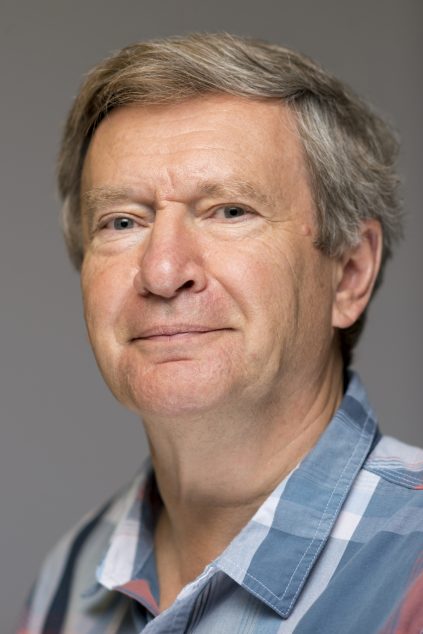Igor Prudovsky
Education
MS – Moscow University. PhD, DSc – Engelhardt Institute of Molecular Biology, Russian Academy of Sceinces.
Biosketch
I am a cell and molecular biologist interested in the biology of growth factors and cytokines and their roles in vascular, metabolic and oncologic pathologies. My specific fields of studies are:
1. Nonclassical secretion of proteins devoid of signal peptide (e.g. FGF1 and IL1), its mechanisms, genetic regulation and effects on cardiovascular system status and cancer growth.
2. Cell memory: ability of cells to “remember” transient interactions with growth factors and thus modulate their response to repeated stimulation. In particular, “FGF memory” discovered in our laboratory could regulate wound repair and tumor incapsulation.
3. Regulation of adipogeneis by growth factors and cytokines (e.g. FGF1, Cthrc1).
Research Interests
While most extracellular proteins has in their structure a special signal peptide, required for their export through endoplasmic reticulum and Golgi, a large group of secreted proteins are devoid of signal peptides, and they are exported through insufficiently studied nonclassical mechanisms. Our laboratory studies the stress-induced nonclassical export, of FGF1 and IL1alpha, two ubiquitous pro-angiogenic and pro-inflammatory molecules. The goals of this project is to understand how multiprotein release complexes are formed, how the released proteins are transported to the cell membrane and how they exit to the extracellular compartment without using the classical mechanism of exocytosis. The understanding of these processes will facilitate the development of new clinical approaches to the regulation of angiogenesis, inflammation and tumor growth.
We also study the interactions between FGF/FGFR, Jagged(Delta)/Notch and thrombin/PAR1 signaling, three major regulatory systems involved in practically all of the aspects of organism development and organ formation. In particular, thrombin stimulation and downregulation of Notch signaling induce FGF1 expression and release, and the acquisition of the angiogenic phenotype by the cells. The aim is to understand molecular mechanisms underlying the cross-talk between FGF, Notch and thrombin signaling and to use this knowledge for the treatment of cardiovascular and oncological disorders.
We developed transgenic mouse models with conditional expression of FGF1 in endothelial cells and monocytes/macrophages. These models are being used to study the regulation of FGF1 export in vivo and its effects on tumor formation and tissue repair after ischemia.
Another topic of our studies is the molecular mechanisms, which regulate cell proliferative response to individual growth factors, including FGFs. We discovered that non-malignant cells respond to FGF by just one proliferative cycle and then indefinitely reside in the G1 phase of the second cycle.
Interestingly, transient treatment with FGF results in a sustained long-term inhibition of proliferative response to FGF, PDGF and EGF. This phenomenon termed “FGF memory” is dependent on histone deacetylase activity and pro-inflammatory NFkappaB signaling. Apparently, the limitation of proliferative response to growth factors may be needed in the organism to prevent tissue hyperplasia, and we are exploring the molecular processes underlying this limitation.
Recently we began the studies of molecular mechanisms underlying the regulation of adipogenesis by FGFs and by a novel hormone-like polypeptide Cthrc1 (discovered by our colleague, MMCRI faculty member Volkhard Lindner).
Selected Publications
- Kacer D, Machnitzky E, Fung A, Greene A, Carter D, Rappold J, Prudovsky I. Anti-fibrinolytic agent tranexamic acid suppresses the endotoxin-induced Tnfa and Il1a genes in plasmin-independent manner. Transfusion 2023 Suppl.3: S168-S176. PMID 37070378.
- Prudovsky I, Kacer D, Zucco VV, Palmeri M, Falank C, Kramer R, Carter D, Rappold J. Tranexamic acid: Beyond antifibrinolysis.Transfusion. 2022 Aug;62 Suppl 1:S301-S312. doi: 10.1111/trf.16976. Epub 2022 Jul 14.
- Prudovsky I. Cellular Mechanisms of FGF-Stimulated Tissue Repair. Cells. 2021, 10 (7):1830.
- Yin H, Favreau-Lessard AJ, deKay JT, Herrmann YR, Robich MP, Koza RA, Prudovsky I, Sawyer DB, Ryzhov S. Protective role of ErbB3 signaling in myeloid cells during adaptation to cardiac pressure overload. J Mol Cell Cardiol. 2021, 152: 1-16.
- Robich M, Ryzhov S, Kacer D, Palmeri M, Peterson SM, Quinn RD, Carter D, Sheppard F, Hayes T, Sawyer DB, Rappold J, Prudovsky I, Kramer RS. Prolonged Cardiopulmonary Bypass is Associated With Endothelial Glycocalyx Degradation. J Surg Res. 2020, 251:287-295.
- Keeley T, Kirov A, Koh WY, Demambro V, Bergquist I, Cotter J, Caradonna P, Siviski ME, Best B, Henderson T, Rosen CJ, Liaw L, Prudovsky I, Small DJ. Resistance to visceral obesity is associated with increased locomotion in mice expressing and endothelial specific fibroblast growth factor 1 transgene. Physiol Rep. 2019 Apr;7(7):e14034.
- Prudovsky I, Carter D, Kacer D, Palmeri M, Soul T, Kumpel C, Pyburn K, Barrett K, DeMambro V, Alexandrov I, Brandina I, Kramer R, Rappold J. Tranexamic acid suppresses the release of mitochondrial DNA, protects the endothelial monolayer and enhances oxidative phosphorylation. J Cell Physiol. 2019, 234, 19121-19.
- Carter DW, Prudovsky I, Kacer D, Soul T, Kumpel C, Pyburn K, Palmeri M, Kramer R, Rappold Tranexamic acid suppresses the release of mitochondrial DAMPs and reduces lung inflammation in a murine burn model. J Trauma Acute Care Surg. 2019, 86:617-624.
- Prudovsky I, Anunciado-Koza R, Jacobs CG, Kacer D, Siviski ME and Koza RA. Mesoderm specific transcript localization in the ER and ER-lipid droplet interface supports a role in adipocyte hypertrophy. J Cellular Biochemistry. 2018, 119:2636-45.
- Liaw L, Prudovsky I, Koza RA, Anunciado-Koza RV, Siviski ME, Lindner V, Friesel RE, Rosen CJ, Baker PR, Simons B, Vary CP. Lipid Profiling of In Vitro Cell Models of Adipogenic Differentiation: Relationships with Mouse Adipose Tissues. J Cellular Biochemistry. 2016, 117, 2182-93.
- Talukder HMA, Preda M, Rhyzova L, Prudovsky I, Pinz IM. Heterozygous caveolin-3 mice show increased susceptibility to palmitate-induced insulin resistance. Physiology Reports. 2016,4, pii: e12736. doi: 10.14814/phy2.12736.
- Prudovsky I, Kacer D, Davis J, Shah V, Jayanthi S, Huber I, Dakshinamurthy R, Ganter O, Soldi R, Neivandt D, Guvench O, Suresh Kumar TK. Folding of Fibroblast Growth Factor 1 Is Critical for Its Nonclassical Release. Biochemistry. 2016: 1159-67.
A complete list of publications can be found on My NCBI.
Service
Since 2011, I have been supervising the module “Stress and adaptation” and presenting part of the lectures of this module.
Dissertation Students

